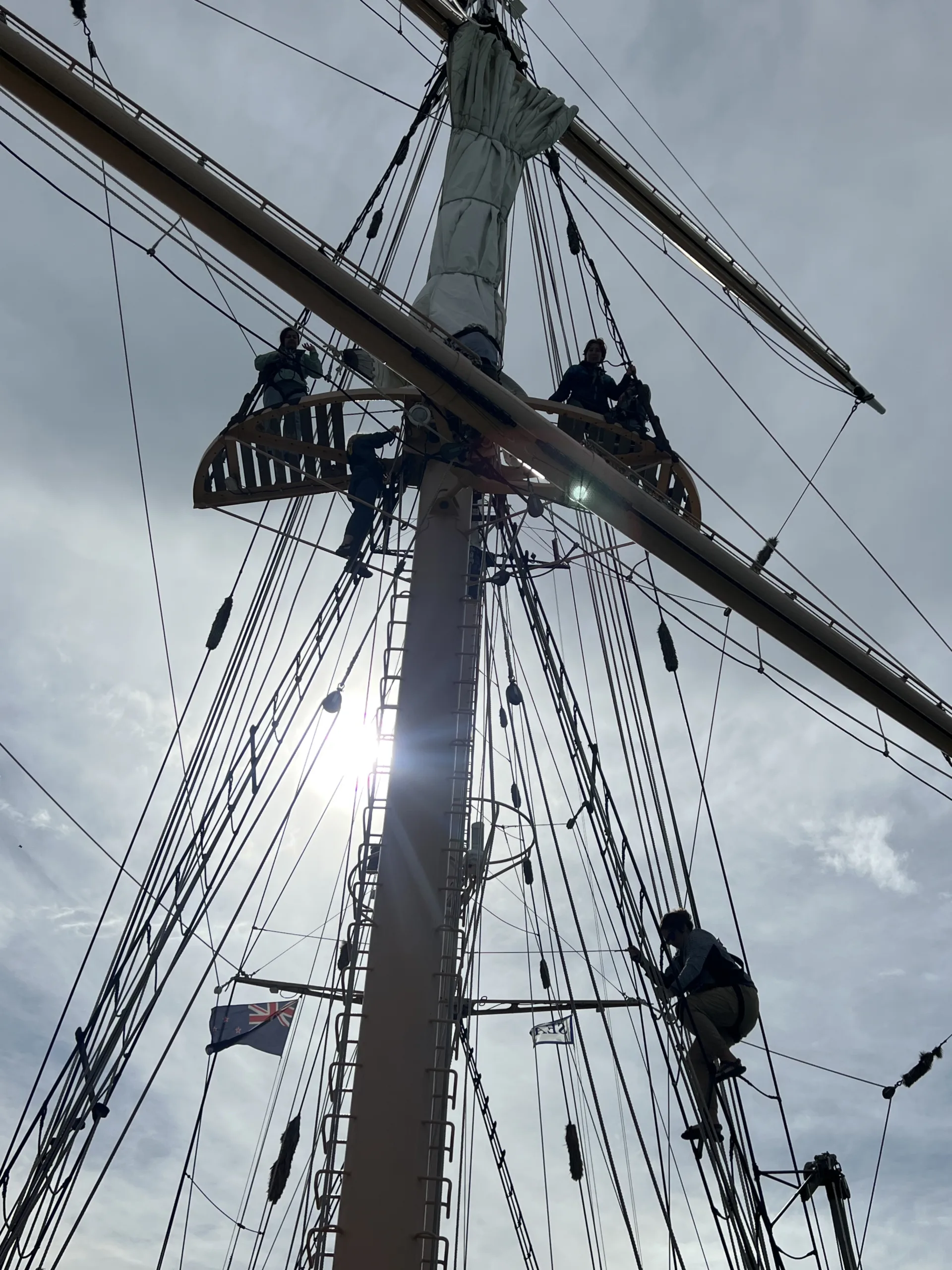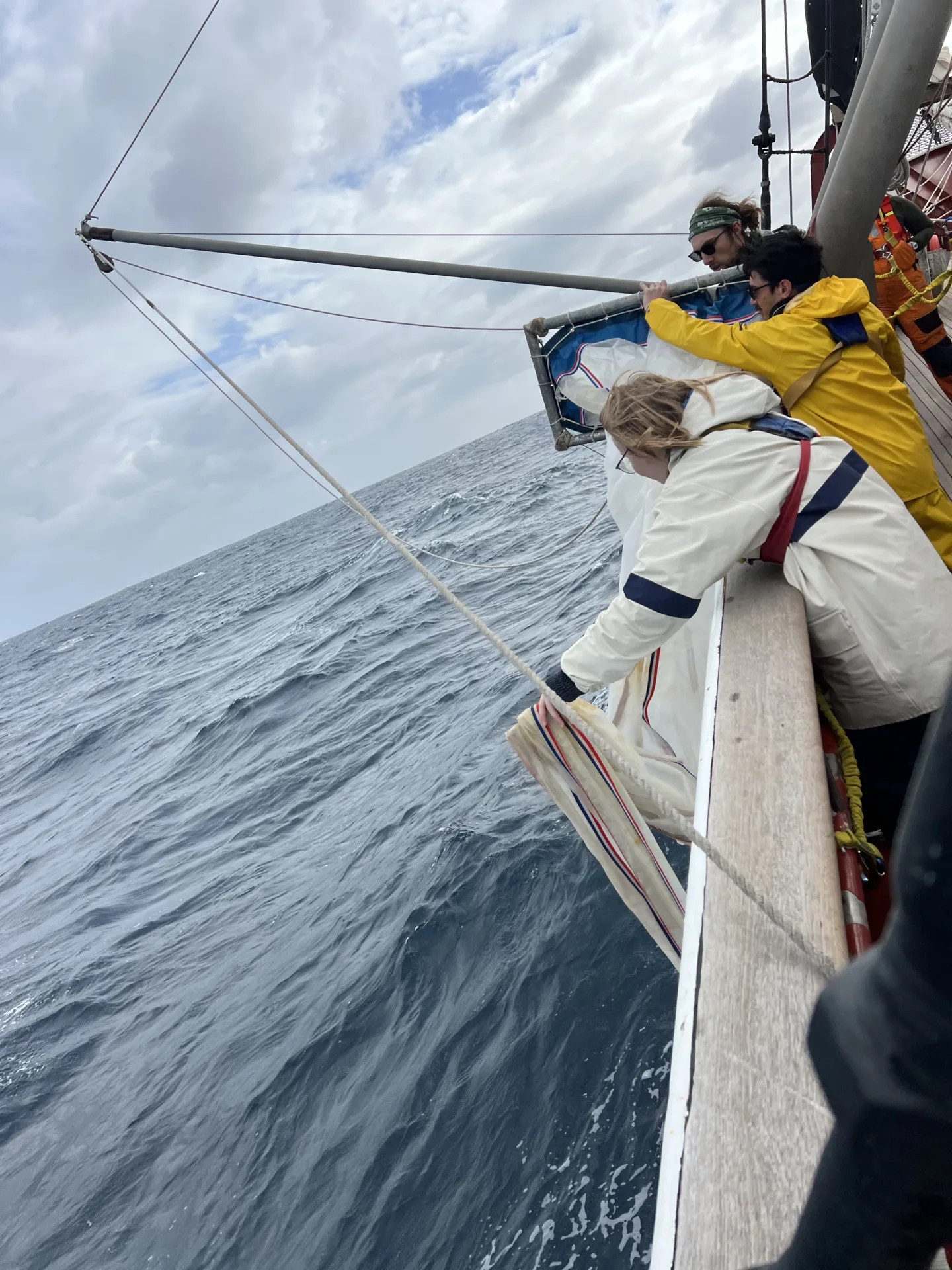Programs Blog
Riding the Waves (Or Rolling with Them)

Date: April 9, 2025
Time: 1606
Location: 40°44.47’ S x 179°25.70’ W
Weather: Wind out of the WSW, Beaufort force 7, 14ft seas out of the SW
This is Resh, back for my second blog post of the program, and it’s our third full day underway! Each watch (the three groups that students are divided into) has officially cycled through the four six-hour shifts: Morning, Afternoon, Evening, and Dawn. I’m on B-watch and our very first shift was Dawn Watch from 1:00 am to 7:00 am. I’ve heard from those on prior voyages that, despite its timing, Dawn Watch had become one of their favorites, and I’m inclined to agree. Our first watch, while a bit bumpy, ended with a sky full of stars and breakfast (the best meal of the day) on the table. Just after breakfast, and before bed for me, we were able to see our first sunrise underway. It was gorgeous, and I look forward to many more.
As is normal, the weather has been quite “sporty” in the few days since departing Lyttelton. I haven’t often heard that term used to describe weather, but now it’s a normal part of my vocabulary. When the weather is sporty, it effectively means that the boat is going to move- a lot. But hey, what better way to find our sea legs! I never realized just how different everyday tasks were at sea. Getting out of bed is hard when the ocean wants you back in your bunk. Good luck getting sleep if it wants you out. And showering? That’s a whole other sport. It has been tricky but fun learning how to balance without knocking dinner off the table or sending a friend off balance. I haven’t done my galley (kitchen) rotation yet, but I’m sure that it will be the ultimate test of my newly found sea legs.
“Standing watch” consists of a variety of different tasks depending on the time of day and your individual assignment. You can be assigned to either lab or deck, although both teams help each other when available. Lab assignments include deploying our equipment to sample the water, processing samples and observing wildlife hourly. Deck assignments can include steering, lookout, sail handling and more. One important part of deck watch is recording weather hourly. We calculate wind direction and speed, cloud coverage and type, temperature, and importantly, sea condition.
Recording the sea condition consists of estimating wave height and direction. As someone not particularly skilled at height estimation, this has been quite the learning curve. Wave height is defined as the distance from the trough (lowest portion) to the crest (highest portion). But how do you tell the lowest part of a wave in a constantly moving ocean? You wait until the boat is at the bottom of one! The advice I’ve been given is wait until the boat rocks downwards a bit and estimate using how far the wave comes up on you. The deck of the boat is about nine feet above the surface and any wave that hits the horizon is roughly that + your height. In my case waves that break the horizon are ~14.5 feet tall. Wave direction (easier in my opinion) is found by using the giant compass in the middle of the ship and adjusting your reading slightly for any errors.
Wave height and direction can tell us about weather conditions and how the boat will move. The most common movement of the boat, especially when sailing, is called rolling. Rolling is when the boat leans from side to side—a motion that occasionally causes dinner to end up on the ground. Waves coming from either side of the boat can cause rolling and, depending on how they hit the boat, bigger waves cause bigger rolls. This can make it difficult to hold our nets steady during science deployments or for the books to stay on the library shelves. Waves are also a reflection of wind speed, duration, and fetch (distance the wind flows over water uninterrupted) which affects which sails we can set and which direction we can steer. Overall, sea conditions affect both our comfort in the boat and our ability to do science deployments, making them an important part of our hourly weather recordings.
In the three days since we have left Lyttelton, I have already learned about aspects of boat life I hadn’t even imagined on shore. I can’t wait to keep learning, sailing and adapting to life at sea! A big shout out to my mom and dad who assisted me on embarking on this amazing adventure. Another to Nadiya and Nayana, my cousins who have promised to read this blog (there will be a quiz). To my amazing friends at home and at school, I can’t wait to catch up on everything! Finally, to my entire family, a huge thank you for your endless love and support.
All the best,
R. Reshmi Mukherjee


Recent Posts from the Ships
- Ocean Classroom 2024-A collaborative high school program with Proctor Academy
- Collaborations and Long-term Commitments: SEA’s Caribbean Reef Program Sets a Course for Coastal Programs that Compliment Shipboard Experiences.
- Sea Education Association students prepare for life underway using state of the art nautical simulation from Wartsila Corporation.
- SEA Writer 2022, Magazines From the Summer SEA Quest Students
- Technology@SEA: Upgrades Allow Insight into Ocean Depths
Programs
- Gap Year
- Ocean Exploration
- High School
- Science at SEA
- SEA Expedition
- SEAScape
- Pre-College
- Proctor Ocean Classroom
- Protecting the Phoenix Islands
- SPICE
- Stanford@SEA
- Undergraduate
- Climate and Society
- Climate Change and Coastal Resilience
- Coral Reef Conservation
- Marine Biodiversity and Conservation
- MBL
- Ocean Exploration: Plastics
- Ocean Policy: Marine Protected Areas
- Oceans and Climate
- Pacific Reef Expedition
- The Global Ocean: Hawai'i
- The Global Ocean: New Zealand